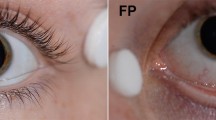Abstract
We examined bright-flash electroretinograms obtained in two Japanese women with pulseless disease. One 48-year-old woman (case 1) who has had the disease for 17 years showed no oscillatory potentials. When she sat and tilted her head to the right, a- and b-wave amplitudes diminished in the left eye. A second 48-year-old woman (case 2) who has had the disease for 10 years also demonstrated absent oscillatory potentials. When she sat and raised her chin, a- and b-wave amplitudes diminished in both eyes. These amplitudes were normal when the patients were in a supine position.
Similar content being viewed by others
References
Font RL, Neumann G (1969) Ocular histopathology in pulseless disease. Arch Ophthalmol 82:782–788
Hirose K (1983) The term “Takayasu's disease” should be abolished. Jpn J Ophthalmol 27:236–247
Horsten GPM, Winkelman JE (1957) Effect of temporary occlusion of the aorta on the electroretinogram. Arch Ophthalmol 57:557–565
Krill AE, Diamond M, Iser G (1962) The electroretinogram in carotid artery disease. Arch Ophthalmol 68:72–81
Kurachi Y, Hirose T, Yonemura D (1966) ERG in pulseless (Takayasu's) disease. Jpn J Ophthalmol [Suppl] 10:106–112
Leonard TJK, Sanders MD (1983) Ischemic optic neuropathy in pulseless disease. Br J Ophthalmol 67:389–392
Nakao K, Ikeda M, Kimata S, Niitani H, Miyahara M, Ishimi Z, Hashiba K, Takeda Y, Ozawa T, Matsushita S, Kuramochi M (1967) Takayasu's arteritis. Clinical report of eighty-four cases and immunological studies of seven cases. Circulation 35:1141–1155
Russell RWR, Ikeda H (1986) Clinical and electrophysiological observations in patients with low pressure retinopathy. Br J Ophthalmol 70:651–656
Takayasu M (1908) A case with curious change in the central retinal artery (in Japanese). Acta Soc Ophthalmol Jpn 12:554–555
Tanaka T, Shimizu K (1987) Retinal arteriovenous shunts in Takayasu disease. Ophthalmology 94:1380–1388
Usami E (1965) The influence of the pressure on ERG of a rabbit, especially on a-wave and oscillatory potential. Jpn J Ophthalmol 9:108–115
Uyama M, Asayama K (1976) Retinal vascular changes in Takayasu's disease (pulseless disease). Occurrence and evolution of the lesion. In: De Lacy JJ (ed) International Symposium on Fluorescein Angiography, Ghent, March 28–April 1, 1976. Junk, The Hague, pp 549–554
Vinijchaikul K (1967) Primary arteritis of the aorta and its main branches (Takayasu's arteriopathy). A clinicopathologic autopsy of eight cases. Am J Med 43:15–27
Wachtmeister L (1987) Basic research and clinical aspects of the oscillatory potentials of the electroretinogram. Doc Ophthalmol 66:187–194
Watanabe I, Miyake Y (1984) Circulatory insufficiency. In: Watanabe I, Miyake Y (eds) ERG · EOG no Rinsho (in Japanese). Igakushoin, Tokyo, pp 102–103
Yonemura D, Aoki T, Tsuzuki K (1962) Electroretinogram in diabetic retinopathy. Acta Ophthalmol (Copenh) 68:19–24
Author information
Authors and Affiliations
Additional information
Offprint requests to: S. Hayasaka
Rights and permissions
About this article
Cite this article
Hayasaka, S., Matsui, H., Noda, S. et al. Electroretinographic responses in patients with pulseless disease vary with head and body positions. Graefe's Arch Clin Exp Ophthalmol 229, 508–511 (1991). https://doi.org/10.1007/BF00203311
Received:
Accepted:
Issue Date:
DOI: https://doi.org/10.1007/BF00203311




